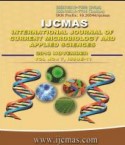


 National Academy of Agricultural Sciences (NAAS)
National Academy of Agricultural Sciences (NAAS)

|
PRINT ISSN : 2319-7692
Online ISSN : 2319-7706 Issues : 12 per year Publisher : Excellent Publishers Email : editorijcmas@gmail.com / submit@ijcmas.com Editor-in-chief: Dr.M.Prakash Index Copernicus ICV 2018: 95.39 NAAS RATING 2020: 5.38 |
The study was carried out to evaluate some insecticides against pod bug, Clavigralla gibbosa Spinola in pigeonpea during kharif 2017-18 at Agricultural Research Station, Kalaburagi, Karnataka, India under field conditions with nine treatments and three replications. The flonicamid 50 WG recorded significantly lowest population of 0.67 bugs per plant while the bug population in acephate 75 SP and thiamethoxam 25 WG was 0.87 and 1.00 bug/plant, respectively and all the three were statistically on par. The maximum population reduction over control was registered in the plot treated with flonicamid 50 WG (94.91 %) followed by acephate 75 SP (93.22 %), tolfenpyrad 15 EC (79.37%) and fipronil 5 EC (77.97 %) at 10 days after spray. Pod damage due to pod bug was lowest in plot treated with flonicamid 50 WG (9.33%) followed by acephate 75 SP (10.67%) and highest in buprofezin 20 SC (16.33%). The grain damage was lowest in flonicamid 50 WG (6.77%) followed by acephate 75 SP (8.72%). Highest grain yield of 1313.27 kg/ha was registered in flonicamid 50 WG followed by acephate 75 SP (1270.31 kg/ha). Similarly, highest benefit: cost ratio of 2.42 in flonicamid 50 WG and 2.38 in acephate 75 SP and was higher than other treatments. Hence, these two insecticides can be suggested for effective management of pigeonpea pod bug.
 |
 |
 |
 |
 |